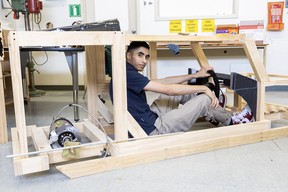London whiz kid building wooden electric vehicle for $1.5K

Article content
A London whiz kid is building his own version of the Mercedes-Benz electric G Wagon for a price that won’t set him back six figures.
Ribal Zebian, a Grade 12 student at Regina Mundi College in London, said his project is intended to inspire young people to think big.
Recommended Videos
“One of the things I’m planning on doing with this car is showcasing it at maybe a mall or at our school. It could inspire younger individuals to do creative things and be innovative,” he said.
“A lot of times, students fear that maybe what they’re going to do doesn’t come together well. . . . If you don’t take a step and start something, you’re never going to make progress. Just taking the first step to do something will bring you closer to the finish line than doing nothing.”
Zebian said his passion for engineering started after he built a wooden stool and chair in construction class and then a table and safe until it got “a bit repetitive.” So he decided to build a car.
“I noticed that there was a way that I could integrate everything that I’ve done, like robotics and woodworking,” Zebian said.
He began his project with a blueprint of the car, a scale drawing based on the dimensions of the Mercedez-Benz vehicle that sells in Canada for $189,000, and a small working prototype.
“Everything is fully designed by me,” Zebian said.
And here’s the catch – the vehicle has to be built on $1,500 from his pocket.

The steering wheel mechanism was going to cost nearly $200, an amount Zebian couldn’t afford.
“So, I designed a way to steer this with only $25 worth of spending,” he said.
Using Styrofoam and cardboard to make the dashboard is another way to reduce costs.
“The purpose of this car is to be sustainable and renewable,” Zebian said. “If it constantly breaks and costs a lot of money, in a sense, that increases your carbon footprint as a consumer.”
The material for the car comes from hardware stores, e-commerce and auto shops. The wood was donated by Chris Hassam, his construction teacher.
Zebian started the project three weeks ago and is making good progress on the 2.5-metre vehicle that will have a full-wing doors, a fully electric motor, a dashboard and one large seat. He works on the vehicle in his spare time between classes and estimates he’s put in 30 hours so far.
He still has to add wheels, headlights and a backup camera as well as a safe he built last spring with motion sensor lights. It will be placed on the back to “make it cooler and give more to the car,” Zebian said.
He expects to make wheels from wood with reinforcements and rubber padding. Zebian said the biggest challenges have been ensuring the side doors are aligned and that the build is 100 per cent square.
Zebian has not come up with a name for the vehicle that he expects to test drive in the school parking lot by the end of May. Though it won’t be licensed for the road, the vehicle will have a battery that will last 20 to 30 minutes at 24 kilometres an hour, he said.
Charging can be done at any electric vehicle charging port, Zebian said, and charging time will be quick due to the vehicle’s small battery.
Zebian’s goal is to land a $120,000 scholarship to study engineering at university. He hopes to pursue architecture and building, including mechatronics, a combination of mechanical, electrical and computer engineering.
“He’s intrinsically motivated,” said Hassam, who has taught Zebian since Grade 9. “I showed him how to use the tools, and then the rest was all him.”
bbaleeiro@postmedia.com













Postmedia is committed to maintaining a lively but civil forum for discussion. Please keep comments relevant and respectful. Comments may take up to an hour to appear on the site. You will receive an email if there is a reply to your comment, an update to a thread you follow or if a user you follow comments. Visit our Community Guidelines for more information.